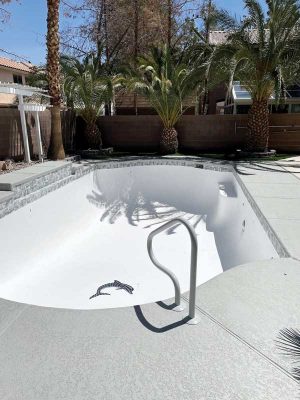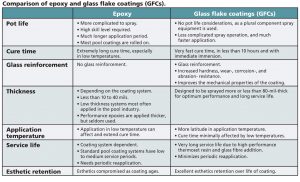
Types of polymers used in the pool industry
When referring to “epoxy paints,” it is important to bear in mind that epoxies are a chemistry, and not a particular type of paint.
- Simple, inexpensive epoxy pool paints. They need constant reapplication and have a short service life.
- Higher quality two-component epoxies. These have a longer service life.
- High-performance, industrial-grade, two-component, 100 per cent solids, zero volatile organic compounds (VOCs). For these, spray application is the preferred application method. They have a longer service life, but are difficult to apply, and have lengthy cure cycles. They also require a high skill level for the application. The common types of epoxies
are novolac epoxies. - Polyurea. These coatings are well-known for their high elongation and extremely fast cure times—sometimes only seconds long. The only drawback of polyurea coatings is producers have not developed products specifically tailored to the pool industry, and because they are not chlorine-tolerant, there needs to be a topcoat with a different paint to protect against chlorine damage. The resins are also very expensive.
- Polyvinyl chloride (PVC) vinyl liners. Another use of polymeric material are PVC vinyl liners. The basic building block polymers are polyvinyl chloride resin. In this case, the product takes the form of a fabric rather than a coating. Vinyl liners are widely used for new pool construction. Although vinyl liners have been attempted for use for pool renovation, especially in commercial pools, their use is very limited. The reason for this is because the structure of the pool must be changed to accommodate the attachment points for the liner. Also, the odd shapes and contours of pools and spas makes installation more complex and time consuming. Compare this to coatings that are sprayed over concrete and immediately conform to the shape of the vessel—no special termination points are required. In addition, vinyl does not have the long-term performance characteristics of high-performance polymeric coatings as those are easier and less costly to install.
- Polymer glass–reinforced composite coatings. These types of coatings and linings have been around for decades and are extremely durable and have a long service life. A major drawback has been bonding to the concrete.
Bonding is an issue because high tensile stresses and resin shrinkage cause the lining to pull away from the surface, leading to disbondment. There are two types of glass reinforcement to use. Chopped-glass fibre sprayed through a chopper gun, and the fibreglass mat method where mat is hand-laid over the concrete. These application methods have become obsolete with the introduction of glass flake coatings (GFCs). GFCs have overcome most of the disadvantages of chopped and hand-laid fibreglass coatings in general, and disbondment in particular.
How GFCs are different from epoxy paints
Although GFCs have been used for decades in the industrial protective coatings sector, they are fairly new to the pool industry. They were introduced because of the shortcomings of some epoxy paints. Many pool operators are looking for extraordinary performance and service life, and these coatings cater to those pool owners.







